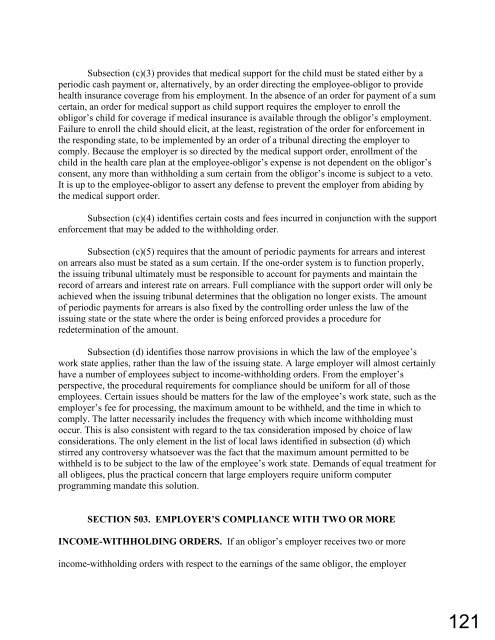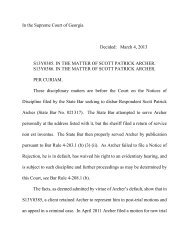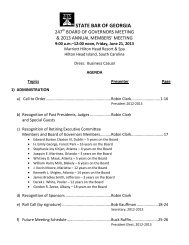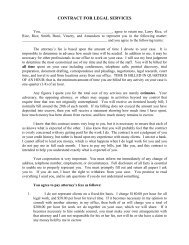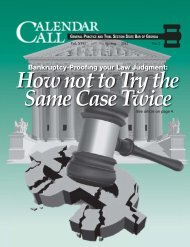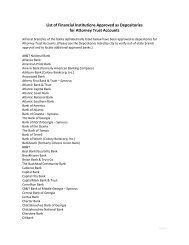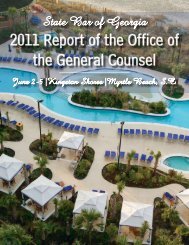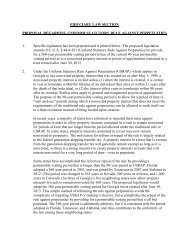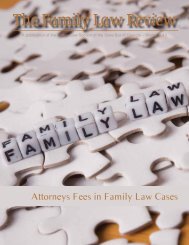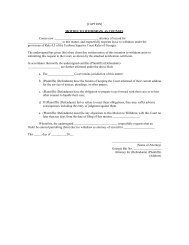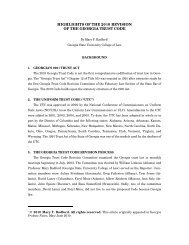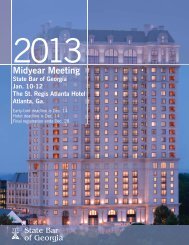2008 Amendments to the Uniform Interstate Family Support Act ...
2008 Amendments to the Uniform Interstate Family Support Act ...
2008 Amendments to the Uniform Interstate Family Support Act ...
Create successful ePaper yourself
Turn your PDF publications into a flip-book with our unique Google optimized e-Paper software.
Subsection (c)(3) provides that medical support for <strong>the</strong> child must be stated ei<strong>the</strong>r by a<br />
periodic cash payment or, alternatively, by an order directing <strong>the</strong> employee-obligor <strong>to</strong> provide<br />
health insurance coverage from his employment. In <strong>the</strong> absence of an order for payment of a sum<br />
certain, an order for medical support as child support requires <strong>the</strong> employer <strong>to</strong> enroll <strong>the</strong><br />
obligor’s child for coverage if medical insurance is available through <strong>the</strong> obligor’s employment.<br />
Failure <strong>to</strong> enroll <strong>the</strong> child should elicit, at <strong>the</strong> least, registration of <strong>the</strong> order for enforcement in<br />
<strong>the</strong> responding state, <strong>to</strong> be implemented by an order of a tribunal directing <strong>the</strong> employer <strong>to</strong><br />
comply. Because <strong>the</strong> employer is so directed by <strong>the</strong> medical support order, enrollment of <strong>the</strong><br />
child in <strong>the</strong> health care plan at <strong>the</strong> employee-obligor’s expense is not dependent on <strong>the</strong> obligor’s<br />
consent, any more than withholding a sum certain from <strong>the</strong> obligor’s income is subject <strong>to</strong> a ve<strong>to</strong>.<br />
It is up <strong>to</strong> <strong>the</strong> employee-obligor <strong>to</strong> assert any defense <strong>to</strong> prevent <strong>the</strong> employer from abiding by<br />
<strong>the</strong> medical support order.<br />
Subsection (c)(4) identifies certain costs and fees incurred in conjunction with <strong>the</strong> support<br />
enforcement that may be added <strong>to</strong> <strong>the</strong> withholding order.<br />
Subsection (c)(5) requires that <strong>the</strong> amount of periodic payments for arrears and interest<br />
on arrears also must be stated as a sum certain. If <strong>the</strong> one-order system is <strong>to</strong> function properly,<br />
<strong>the</strong> issuing tribunal ultimately must be responsible <strong>to</strong> account for payments and maintain <strong>the</strong><br />
record of arrears and interest rate on arrears. Full compliance with <strong>the</strong> support order will only be<br />
achieved when <strong>the</strong> issuing tribunal determines that <strong>the</strong> obligation no longer exists. The amount<br />
of periodic payments for arrears is also fixed by <strong>the</strong> controlling order unless <strong>the</strong> law of <strong>the</strong><br />
issuing state or <strong>the</strong> state where <strong>the</strong> order is being enforced provides a procedure for<br />
redetermination of <strong>the</strong> amount.<br />
Subsection (d) identifies those narrow provisions in which <strong>the</strong> law of <strong>the</strong> employee’s<br />
work state applies, ra<strong>the</strong>r than <strong>the</strong> law of <strong>the</strong> issuing state. A large employer will almost certainly<br />
have a number of employees subject <strong>to</strong> income-withholding orders. From <strong>the</strong> employer’s<br />
perspective, <strong>the</strong> procedural requirements for compliance should be uniform for all of those<br />
employees. Certain issues should be matters for <strong>the</strong> law of <strong>the</strong> employee’s work state, such as <strong>the</strong><br />
employer’s fee for processing, <strong>the</strong> maximum amount <strong>to</strong> be withheld, and <strong>the</strong> time in which <strong>to</strong><br />
comply. The latter necessarily includes <strong>the</strong> frequency with which income withholding must<br />
occur. This is also consistent with regard <strong>to</strong> <strong>the</strong> tax consideration imposed by choice of law<br />
considerations. The only element in <strong>the</strong> list of local laws identified in subsection (d) which<br />
stirred any controversy whatsoever was <strong>the</strong> fact that <strong>the</strong> maximum amount permitted <strong>to</strong> be<br />
withheld is <strong>to</strong> be subject <strong>to</strong> <strong>the</strong> law of <strong>the</strong> employee’s work state. Demands of equal treatment for<br />
all obligees, plus <strong>the</strong> practical concern that large employers require uniform computer<br />
programming mandate this solution.<br />
SECTION 503. EMPLOYER’S COMPLIANCE WITH TWO OR MORE<br />
INCOME-WITHHOLDING ORDERS. If an obligor’s employer receives two or more<br />
income-withholding orders with respect <strong>to</strong> <strong>the</strong> earnings of <strong>the</strong> same obligor, <strong>the</strong> employer<br />
121


